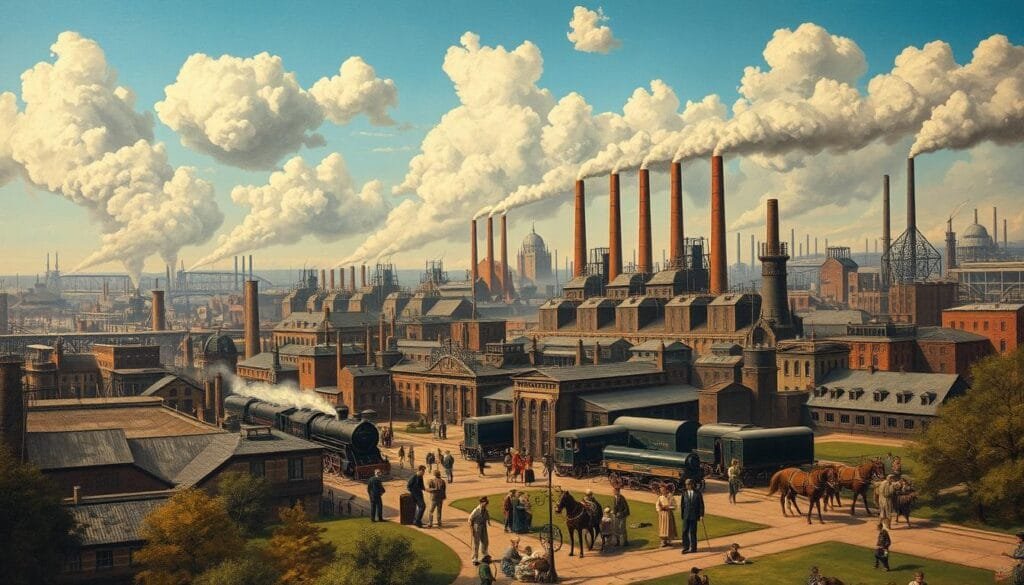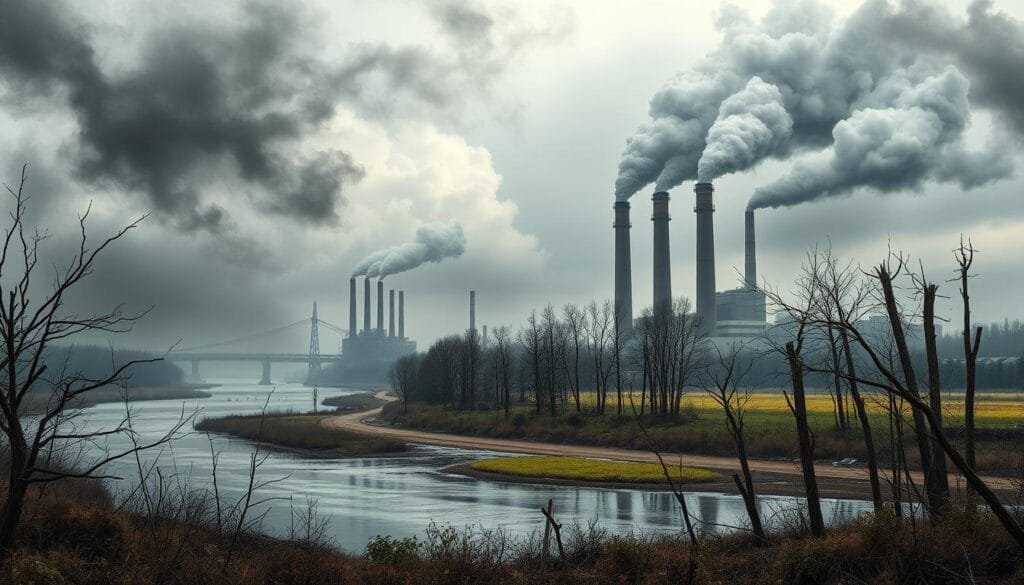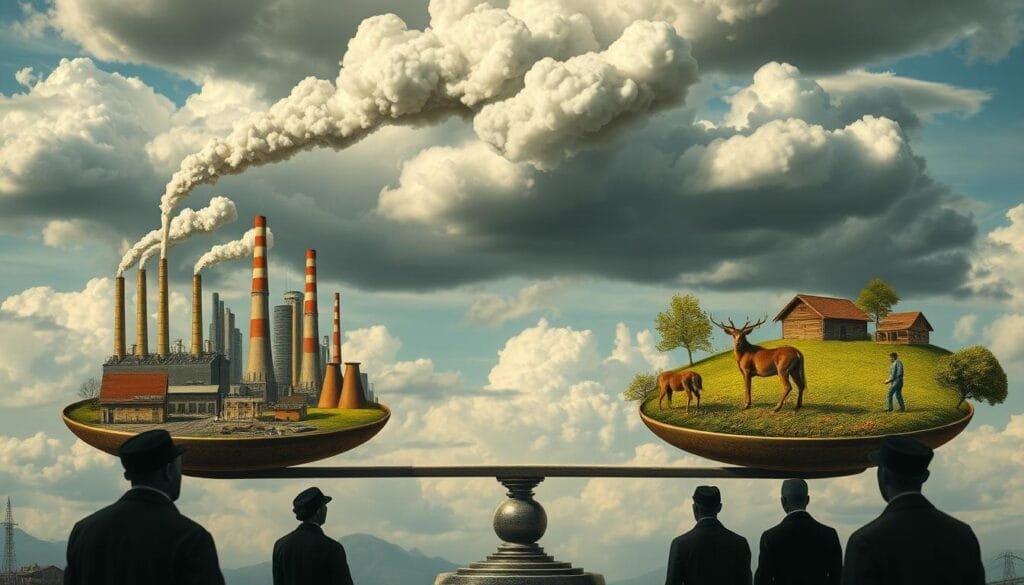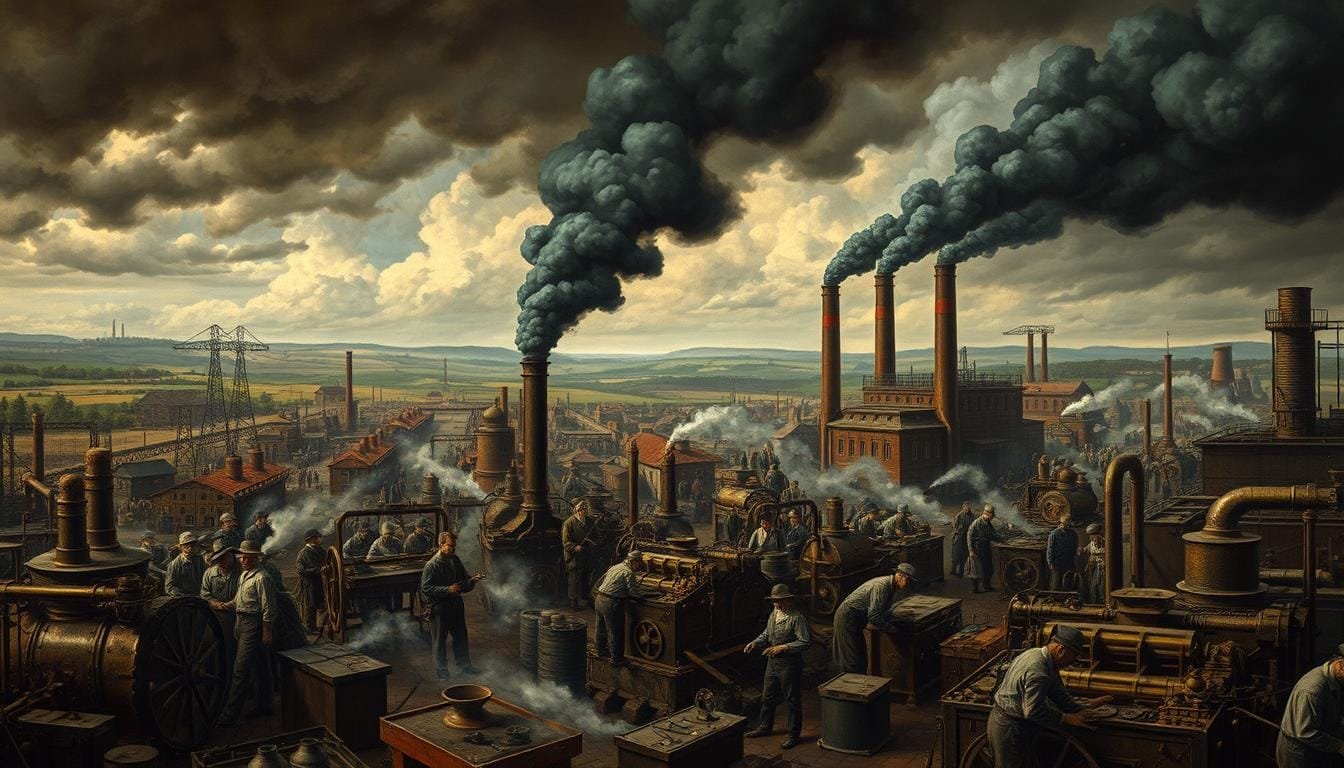The Industrial Revolution deeply changed modern society. It started in the mid-18th century in the United Kingdom. This era introduced big changes in technology, society, politics, and the environment.
It changed how things were made and increased industries’ power. This shift also changed how people worked and lived together. It affected our relationship with nature too.
The Revolution didn’t just stay in Britain; it reached Europe and the New World by 1850. This period brought both good and bad things. For instance, Britain became very rich and had a big market.
But, there was a dark side too, like the harsh use of child labor. This shows the complex impact of the Industrial Revolution on society.
The era also brought dangerous living and working conditions. These negative effects show the mixed outcomes of progress. It reminds us to look closely at technology’s impact on life.
Key Takeaways
- The Industrial Revolution started in the United Kingdom in the 18th century and went global by 1850.
- By 1850, industrialization made Britain the richest country.
- It led to economic growth but also social issues.
- Workers often had very long and dangerous workdays.
- This era changed economies and societies all over the world.
The Origins and Spread of the Industrial Revolution
The Industrial Revolution was a major turning point in history, moving from farming to factory-based economies. It started in Great Britain in the mid-to-late 1700s. A mix of reasons kick-started this big change.
The Agricultural Revolution as a Catalyst
The agricultural revolution played a key part in the industrial one. New farming methods led to more food and freed workers for factories. Things like crop rotation and better animal breeding helped produce more food with fewer people. This allowed some rural folks to move into industrial jobs, setting Britain on its industrial path.
Technological Innovations
Inventions played a huge role in the Industrial Revolution. The mechanized loom and steam engine made making things faster and needed less human labor. For example, James Watt upgraded the steam engine, powering a variety of industries. This time also saw the spinning jenny and power loom, boosting manufacturing further.
Geographical Advantages of Britain
Britain’s geography greatly helped its industrial success. It had lots of coal and iron, vital for machines and buildings. Its small size made transport and communication easier, important for industry. Britain’s rivers, ports, and large colonial markets were key to its role as the birthplace of the Industrial Revolution.
Economic Benefits of the Industrial Revolution
The Industrial Revolution profoundly changed society. It made goods cheaper and easier to get because of innovations.
Accessibility and Affordability of Goods
Goods were made more efficiently and at lower costs during the Industrial Revolution. Wages for workers in England went up, and more products were available at lower prices. This led to more people buying more things. For example, the Lindert-Williamson index shows growth from 50 to 100 during these years. This made life better for many people.
Evolution of Labor-Saving Inventions
Inventions like the spinning jenny, power loom, and steam engine changed how things were made. They cut labor costs and made factories produce more. These inventions were key to the economic growth of the time. N. F. R. Crafts noted that British income per person went from $400 in 1760 to $800 in 1860. This shows how these inventions boosted the economy and productivity.
Medical Advancements
Medical breakthroughs during the Industrial Revolution also helped improve public health. In England, life expectancy rose from thirty-five to forty years between 1781 and 1851. Innovations like vaccines and better surgery techniques helped people live longer. These health improvements also helped grow the workforce, needed for the expanding economy.
The Industrial Revolution brought economic gains in many ways. It made goods more affordable, introduced labor-saving inventions, and led to major medical advancements. Together, these changes ushered in a new era of prosperity and social change.
Social Changes and Improvements in Quality of Life
The Industrial Revolution brought huge social changes, shaping today’s society. A key change was the birth of a middle class thanks to economic growth. This new middle class greatly improved how some people lived and worked. The period also saw more types of jobs as people moved to cities for work.

Creation of a Middle Class
The middle class emerged from the Industrial Revolution’s economic changes. Economic growth helped families climb the social ladder. Many found jobs in new industries and cities. For example, American cities grew by 15 million in the late 1800s. This growth made urban areas more lively and drove economic progress. Changes in society also led to better city planning and living conditions.
New York City’s population soared, nearly seven times in 50 years, hitting 3.5 million by 1900. This growth lifted the middle class, demanding better living conditions. This led to urban renewal efforts. Better diets and vaccinations also increased life expectancy, improving life quality.
Rise of Specialist Professions
Specialist jobs became more common during the Industrial Revolution. These jobs needed special skills and training. The rise in complex industries and technology drove this need. For instance, Thomas Savery built the first working steam engine in 1698. Later, James Watt made it even better, fueling industrial growth.
Jobs started to need specific skills. This was clear as immigrants, women, and children joined the workforce. Women and children helped their families, despite low pay and tough conditions. But, these specialized professions supported growing industries, like textiles and coal mining. Learn more about these social changes here.
Environmental and Health Drawbacks
The Industrial Revolution changed the economy greatly but also caused big environmental and health issues. The environmental impact of the Industrial Revolution can’t be ignored, as it led to serious pollution and harmed nature. Also, the swift move of people to cities brought a lot of workplace health risks and urban living conditions problems, causing many public health problems.
Pollution and Environmental Degradation
The environmental impact of the Industrial Revolution was major. In 2019, the level of CO2 in the air reached 409.8 ppm. This was a big jump from the 280 ppm seen before industries took off. The increase in CO2 from 0.7 ppm per year in the 1950s to 2.1 ppm per year recently shows the big environmental cost of industrial growth. The Asia-Pacific region saw the biggest effects, with countries like India and China being big emitters, with China at 10.06% and India at 7% of the world’s total.

Poor Working Conditions
During the Industrial Revolution, workplaces were often dangerous, and factory workers had to work up to 14 hours a day, six days a week. These conditions were not safe and led to many getting hurt. In the 1830s, the British Parliament made laws to improve conditions in mines and factories, especially for women and children, to address these workplace health risks. Despite these changes, dangers were still common in the new industrial places in Europe and elsewhere.
Overcrowded and Unsanitary Living Conditions
With more industries, cities grew fast and became very crowded, creating serious urban living conditions issues. The lack of enough toilets and clean water led to the spread of diseases and worsened public health problems. The big move from the countryside to cities made it hard to find enough houses and keep places clean, showing the big negatives of fast industrial growth.
| Industrial Factor | Data |
|---|---|
| Pre-Industrial CO2 Level | 280 ppm |
| 2019 CO2 Level | 409.8 ppm |
| Increase in CO2 Concentration | 0.7 ppm/year (1950s) to 2.1 ppm/year (2010s) |
| Global Greenhouse Gas Emissions | China: 10.06%, India: 7% |
| Average Working Hours | 14 hours/day, 6 days/week |
| Year British Parliament Reformed | 1830s |
Was the Industrial Revolution Beneficial or Harmful to Society?
The Industrial Revolution is a complex topic, involving both gains and losses. From 1860 to 1900, the U.S. changed a lot. Fourteen million immigrants came, offering lots of labor. This period also saw Andrew Carnegie’s steel mills and John D. Rockefeller’s oil dominance, leading to huge economic growth.

But, this growth had a dark side. It hurt the environment and society a lot. Carbon dioxide levels went way up, from 275-290 ppmv before 1750 to over 400 ppmv by 2017. Cities grew fast, leading to poor living conditions. This forced the Progressive Movement to step in.
“The Great Railroad Strike of 1877 emphasized the growing discontent among workers facing harsh conditions such as 14-16 hour workdays in unsafe environments.”
Child labor was another big problem, putting kids in dangerous jobs for little pay. Labor unions began to form, fighting for worker rights. Meanwhile, inventors like Alexander Graham Bell and Thomas Edison made big strides. But, these new machines also led to health issues due to less physical activity.
Our in-depth look shows a stark comparison of the Industrial Revolution’s goods and bads:
| Aspect | Benefits | Drawbacks |
|---|---|---|
| Economic Growth | Expansion of industries, job creation | Monopolies, worker exploitation |
| Technological Innovation | Improved productivity, enhanced communication | Increased pollution, sedentary lifestyle |
| Urbanization | Development of cities, middle-class emergence | Overcrowding, poor living conditions |
| Labor | Provision of jobs for immigrants, economic inclusivity | Child labor, long working hours |
In the end, it’s important to balance the good and bad of the Industrial Revolution. It tells a story that’s both informative and a warning. It makes us think about past lessons.
Conclusion
The Industrial Revolution started in England in the mid-18th century. It changed the world greatly. This period brought economic growth, new types of businesses, and big tech advancements. These laid the foundation for our modern industry.
Along with its benefits, the Industrial Revolution had downsides. It caused pollution and health problems. Work and living conditions were bad. There was child labor and unequal pay for women. Yet, these issues led to the rise of labor rights and feminism.
Looking ahead, we must remember the lessons from the Industrial Revolution. As we aim for growth and sustainability, these lessons are crucial. They remind us to protect the environment and care about social welfare. Innovations today, like AI and zero-carbon technologies, continue this era’s legacy. The story of the Industrial Revolution teaches us how to face future challenges.
FAQ
What were the main societal impacts of the Industrial Revolution?
The Industrial Revolution created a big middle class and specialist jobs. It made goods cheaper and easier to get. This change helped the economy grow and brought new inventions.
How did the Agricultural Revolution contribute to the Industrial Revolution?
The Agricultural Revolution made more food and freed up workers. This was key for the industries’ growth. It let more people move to cities for work, boosting the Industrial Revolution.
What technological innovations were pivotal during the Industrial Revolution?
Important inventions were things like mechanized looms and steam engines. They changed how things were made. These innovations cut labor costs and helped the economy and industries grow.
Why was Britain the birthplace of the Industrial Revolution?
Britain had coal and iron, plus a great location for transport. Also, it had a big market for goods. Combined with its agriculture and technology, Britain led the Industrial Revolution.
What were the economic benefits of the Industrial Revolution?
It made goods cheaper and more available. This changed the economy. Inventions made work easier and the economy grew. Health advances also helped people live longer and healthier lives.
How did the Industrial Revolution affect the social structure?
It created a middle class and new jobs in cities. This wealth helped the new class grow. Industry needed skilled workers, leading to more jobs and services.
What were the environmental and health drawbacks of the Industrial Revolution?
It caused a lot of pollution and hurt the environment. Workers had bad conditions and long hours. Cities were crowded and dirty, leading to more diseases.
Was the Industrial Revolution beneficial or harmful to society?
The Industrial Revolution had good and bad sides. It pushed technology and made societies richer. But, it also caused environmental and health problems. Looking at it all, it shows the challenge in balancing progress with care for the environment and health.
